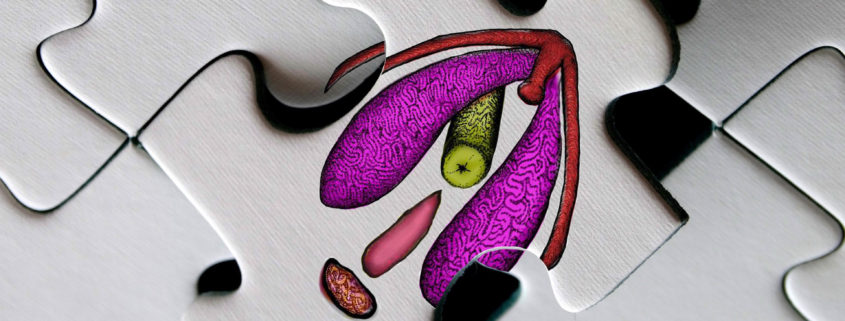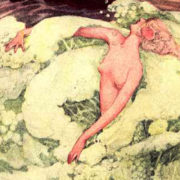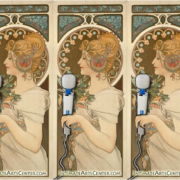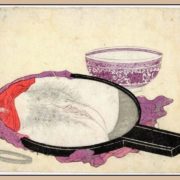The Missing Female Pleasure Parts
The Search for Buried Pleasure
What’s wrong with our standard map of female genital anatomy? Unfortunately, what’s missing from the picture is most of the equipment responsible for pleasure, arousal and orgasm. The clitoris is just the tip of the volcano!
Women have a set of interconnected but separate erectile structures that I call the Female Erectile Network (“FEN”). It’s comprised of multiple parts that are functionally and structurally connected. They are the three parts of the clitoris, the paired vestibular bulbs, the urethral sponge and the perineal sponge.
While it’s beyond the scope of this article to go into detail about each of the female erectile structures, I do want to point out a few salient bits of information about the erectile network. Erectile tissue is penises are mostly made of. It’s what gives them the ability to go from small and soft to big and hard.
Here’s the key point: Pound for pound and inch for inch, women have just as much erectile tissue as men. It’s just arranged differently. The female genitals contain just as much of this expandable, engorgable, highly pleasurable tissue as male genitals do. Just as much!
Some of these pleasure parts are well known while others are almost unheard of (even by scientists, medical practitioners and sexologists).
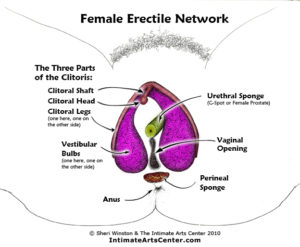 To start with the familiar, the FEN includes the super-sensitive ‘jewel in the crown’—the head of the clitoris. (That’s what most people are referring to when they say ‘clitoris.’) It’s a unique and remarkable structure and merits lots of attention. The clitoral head is the main and usually easiest orgasmic trigger for most women. It is not, however, the only path to female sexual pleasure. Just for starters, the clitoris itself also includes two other parts: the shaft (under the hood) and the three to four inch-long paired legs. And they are all composed of—that’s right—erectile tissue!
To start with the familiar, the FEN includes the super-sensitive ‘jewel in the crown’—the head of the clitoris. (That’s what most people are referring to when they say ‘clitoris.’) It’s a unique and remarkable structure and merits lots of attention. The clitoral head is the main and usually easiest orgasmic trigger for most women. It is not, however, the only path to female sexual pleasure. Just for starters, the clitoris itself also includes two other parts: the shaft (under the hood) and the three to four inch-long paired legs. And they are all composed of—that’s right—erectile tissue!
But that’s not all! In addition to the clitoral structures, the FEN includes the paired vestibular bulbs that bracket the vaginal opening, plus two additional structures—the urethral and perineal sponges.
The Vestibular Bulbs
These two substantial wads of erectile tissue are positioned on either side of the vaginal opening. Shaped like an upside-down comma, they’re thin at the top where they connect to the shaft of the clitoris. At the bottom each bulb is, well, bulbous. When engorged they swell, like all erectile tissue does. At that point, they cause the labia to bulge out and in and create intensely pleasurable sensations when stimulated, including when anything is moving into and out of the vagina. They can be stimulated by broadly pressing the whole vulva and labia and by ‘rubbing through the skin’, that is, using moderate to deep pressure to stroke the structure under the skin. When stimulated, they puff up considerably. The bulbs are are one of the important keys to increased female pleasure!
The Urethral Sponge
Another component of the Female Erectile Network is the structure known as the urethral sponge (a/k/a the female prostate). Comprised of erectile and glandular tissue, it’s a cylinder of erectile tissue that surrounds the tube of the urethra— like a roll of paper towels surrounding the inner cardboard tube. It’s analogous to the male prostate.
The urethral sponge can be stimulated through the roof of the vagina and by pleasuring the area surrounding the urethral opening. But it is not a magic orgasm button. Most women will not enjoy having it stimulated until after they’ve reached mid-to high level arousal.
Here’s a little-known fact lots of people miss—the underside of the tubular sponge is what in common (and incorrect) parlance is known as the g-spot. I prefer not to use that term. It is not a spot—it’s the bottom of the tube of the urethral sponge. So while I can truthfully say that the ‘g-spot’ as an anatomical structure doesn’t exist, the erectile tissue known as the urethral sponge most assuredly does. Got it? There is no g-spot, but there is a urethral sponge—an engorgeable (and potentially pleasurable) erectile tissue tube that lies just above the roof of the vagina.
The Perineal Sponge
The perineal sponge rests under the vaginal floor, in the wall between the vaginal and anal canals. It can be accessed via either passageway (or both!) It is also composed of engorgeable erectile tissue.
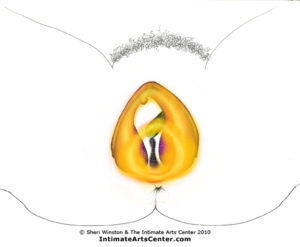 Connected Circuits
Connected Circuits
Each of the network’s structures is composed of erotically responsive erectile tissue. With proper stimulation, each can become engorged. When the whole female erectile network is engorged, it creates two overlapping, interlocking connected circuits of sweetly swollen erectile structures. While women can become aroused and orgasmic with only some of the network activated, for maximum pleasure get the whole network engorged. When all of the separate structures are engaged, the erectile network becomes like a snug and stretchy cuff of delightfully responsive equipment. Getting one component stimulated and engorged is good. Getting the whole network puffed up and pleasured is way better!
More Pleasure, Please!
When the whole network is activated, women are more likely to reach orgasm by a variety of forms of stimulation. All orgasms are good. None are superior–there aren’t any ways of getting to orgasm that are better or worse. For most women, direct stimulation to the clitoral head is required to get there. Woman can, however learn to expand their paths to orgasm, expand their orgasms and widen their orgasmic spectrum.
 One way that many women would like to get orgasmic is with intercourse or penetration. Despite our cultural misconceptions, this is not the easiest way to get off (or help your partner get to the big O)! Learning to have orgasms from penetration is a learnable skill. One key to making intercourse highly pleasurable and much more likely to be orgasmic (for the woman) is to make sure that the whole circuit of erectile tissue is fully engorged prior to penetration. Other keys include making sure that the woman is in deep, high-level arousal prior to penetration; using our additional inner ‘sexcraft tools’ (such as breathing, sound, movement, awareness and imagination, to name just a few) to increase stimulation; having one or more orgasms prior to intercourse; and, during intercourse, using more pelvis-connected movements such as rocking or grinding rather than a penis thrusting in-and-out motion. These type of movements will stimulate the whole erectile network better then the old in-and-out.
One way that many women would like to get orgasmic is with intercourse or penetration. Despite our cultural misconceptions, this is not the easiest way to get off (or help your partner get to the big O)! Learning to have orgasms from penetration is a learnable skill. One key to making intercourse highly pleasurable and much more likely to be orgasmic (for the woman) is to make sure that the whole circuit of erectile tissue is fully engorged prior to penetration. Other keys include making sure that the woman is in deep, high-level arousal prior to penetration; using our additional inner ‘sexcraft tools’ (such as breathing, sound, movement, awareness and imagination, to name just a few) to increase stimulation; having one or more orgasms prior to intercourse; and, during intercourse, using more pelvis-connected movements such as rocking or grinding rather than a penis thrusting in-and-out motion. These type of movements will stimulate the whole erectile network better then the old in-and-out.
However you use your erectile equipment (or pleasure a female partner’s parts), take the time to play with the whole erectile network. A full-on ‘herection’ is a beautiful, elegant and very rewarding pleasure matrix.
Do you like the idea of getting empowering, entertaining, erotic education for adults ONLINE? If so, we invite you to check out our Intimate Arts Online live and recorded online classes and courses. Discover a convenient, private and enlightening way to have more pleasure and expand your erotic universe. You’ll be glad you did!
If you want to learn more about women’s astounding, engorgable and delightful erotic equipment, there are multiple ways to do so.
Get More Women’s Anatomy of Arousal!
Given how much interest there’s been in the topic historically, you’d expect people to know all there is to know about female sexuality and female genital anatomy. Well, they don’t. The vast majority of people know amazingly little about women’s sexual parts—and this is true for owners of the equipment as well as people who like to play there.
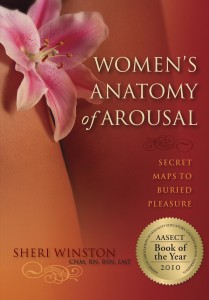

Read the award-winning Women’s Anatomy of Arousal book.
WINNER, 2010 BOOK OF THE YEAR AWARD! (From The American Assoc of Sex Educators, Counselors & Therapists) Find out why Dr. Christiane Northrup has called Women’s Anatomy of Arousal “the most comprehensive, user-friendly, practical and uplifting book on women’s sexuality I’ve ever read. It’s the gold standard!”
Take the Women’s Anatomy of Arousal online course.
Includes four recorded webinars, private ‘home room’ page with text and video resources, ‘home play’ assignments, and ‘forever’ access to the webinars.
Save

